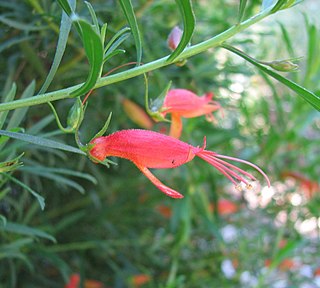
Eremophila decipiens, commonly known as slender fuchsia bush or narrow-leaved fuchsia bush is a flowering plant in the figwort family, Scrophulariaceae and is endemic to an area extending from the south-west of Western Australia to southern parts of South Australia. It is low, sprawling shrub with lance-shaped leaves and red, orange or yellow flowers on a long, S-shaped stalk.

Eremophila subteretifolia, commonly known as Lake King eremophila, is a flowering plant in the figwort family, Scrophulariaceae and is endemic to Western Australia. It is a creeping, prostrate shrub with narrow, sticky, dark green leaves and distinctive orange-red to yellow flowers. It is a rare plant which grows near the edges of salt lakes.
Eremophila ciliata, commonly known as Archer's eremophila is a flowering plant in the figwort family, Scrophulariaceae and is endemic to a small area in the south of Western Australia. It is an erect, spreading shrub with short, thick leaves and small lilac to mauve flowers. It is only known from a population of about 100 plants.
Eremophila coacta is a flowering plant in the figwort family, Scrophulariaceae and is endemic to a small area in the north west of Western Australia. It is an erect shrub with narrow, sticky, pointed leaves and densely hairy light to dark lilac-coloured flowers.
Eremophila cryptothrix is a flowering plant in the figwort family, Scrophulariaceae and is endemic to the Pilbara region of Western Australia. It is a shrub with sticky stems due to the presence of resin, narrow leaves, coloured sepals and white, pale pink or pale blue flowers.
Eremophila dendritica is a flowering plant in the figwort family, Scrophulariaceae and is endemic to the south of Australia. It is a low, shrub with many tangled branches. Its branches, leaves and flowers are densely covered with hairs giving them a felty texture.

Eremophila densifolia is a flowering plant in the figwort family, Scrophulariaceae and is endemic to the south-west of Western Australia. It is usually a low, spreading shrub with densely clustered leaves and lilac to purple flowers.
Eremophila eversa is a flowering plant in the figwort family, Scrophulariaceae and is endemic to a restricted area of Western Australia. It is known from only one plant, now thought to have died. It is a small shrub with small leaves and hairy purple to lilac-coloured flowers.
Eremophila fallax is a flowering plant in the figwort family, Scrophulariaceae and is endemic to Australia. It is a densely-foliaged shrub with leaves which have a hooked tip and with blue to violet flowers. It occurs in South Australia and Western Australia. Without flowers, this species closely resembles Eremophila deserti but that species has 5 stamens and its fruits are a different shape.

Eremophila flaccida is a flowering plant in the figwort family, Scrophulariaceae and is endemic to Western Australia. It is a low, spreading shrub with sticky, shiny foliage and large, attractive flowers. There are two subspecies, one common and relatively widespread, the other known from only a few locations.
Eremophila lanata is a flowering plant in the figwort family, Scrophulariaceae and is endemic to Western Australia. It is a small shrub with small, hairy leaves, densely hairy sepals and lilac to pinkish flowers.

Eremophila mirabilis is a flowering plant in the figwort family, Scrophulariaceae and is endemic to Western Australia. It is a shrub with narrow leaves, brightly coloured sepals and petals growing in two widely separated areas.

Eremophila phyllopoda is a flowering plant in the figwort family, Scrophulariaceae and is endemic to Western Australia. It is an erect or spreading shrub, sometimes round or flat-topped with sticky, hairy leaves and flowers ranging in colour from pink or lilac to purple.

Eremophila platythamnos, commonly known as desert foxglove, is a flowering plant in the figwort family, Scrophulariaceae and is endemic to Australia. It is an erect shrub with short, broad leaves and purple, mauve, blue or pink flowers.

Eremophila rigens is a flowering plant in the figwort family, Scrophulariaceae and is endemic to Western Australia. It is an erect shrub with long, stiff, glabrous leaves and pale lilac-coloured to white flowers.

Eremophila rigida is a flowering plant in the figwort family, Scrophulariaceae and is endemic to Western Australia. It is an erect, rigid shrub with thick, hairy, rigid leaves and pale yellowish-cream flowers.
Eremophila rostrata is a flowering plant in the figwort family, Scrophulariaceae and is endemic to Western Australia. It is an erect shrub with cylinder-shaped leaves, small sepals and glabrous, pink to deep red petals. There are two subspecies, both of which are critically endangered.
Eremophila setacea is a flowering plant in the figwort family, Scrophulariaceae and is endemic to Western Australia. It is an erect shrub with narrow, glabrous leaves, hairy sepals and light blue to purple petals.
Eremophila shonae is a flowering plant in the figwort family, Scrophulariaceae and is endemic to Western Australia. It is an erect shrub or a low spreading shrub, depending on subspecies and has very sticky branches and leaves due to the presence of large amounts of resin. The leaves are narrow and the flowers are mauve to purple and white inside with purple spots.

Eremophila veneta, commonly known as metallic-flowered eremophila is a flowering plant in the figwort family, Scrophulariaceae and is endemic to Western Australia. It is a low, spreading, sticky shrub with dark green leaves and bluish-green petals.











